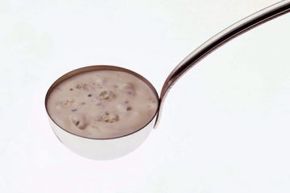 “One ladle of salad dressing (about four teaspoons) packs about 800 milligrams of sodium. See pictures of sensational salads.Jupiterimages/Thinkstock
“One ladle of salad dressing (about four teaspoons) packs about 800 milligrams of sodium. See pictures of sensational salads.Jupiterimages/Thinkstock
Oh, salt. So tasty, yet so bad for us. We need it to live, but too much can lead to high blood pressure and early death. Because salt is so hard to find in the wild, our ancestors evolved to crave it, but it’s a dangerous biological heritage. Instead of having to get our salt from mineral deposits and animal blood (both of which taste terrible on salad, incidentally), we can get a super-sized sodium dose in just about anything we eat.
Part of the problem lies in processed foods, namely that we are eating way too much of them. According to the Mayo Clinic, processed foods account for about 77 percent of Americans’ sodium intake. Those processed foods include salad dressings, which are some of the saltiest offenders. Two teaspoons of commercial salad dressing can have anywhere from 200 to 400 milligrams of sodium. That’s just one serving, but who only uses two teaspoons of salad dressing when a dollop from a ladle at a salad bar is usually about four? And while 2,300 milligrams of sodium is the recommended daily maximum, if you’re watching your salt intake, you really should be shooting for closer to 1,500 milligrams.
That’s bad news, but there’s a bright side: If you need to cut down on the amount of sodium in your diet, salad dressing is one of the best places to start. However, as you may have noticed, high-sodium salad dressings are delicious while "lite" and "low-sodium" dressings are often bland and unappetizing. Can you really expect to find a low-sodium salad dressing that doesn’t taste like liquid paper?
The short answer is yes, but all salad dressings are not created alike. Vinegar and olive oil dressings tend to have the least salt in them, but vinaigrettes can get a little dull. Other staples like Russian, Thousand Island and Ranch dressings are almost always loaded to the gills with salt, and their low-sodium counterparts are faint shadows of the originals.
Luckily, you can make your own salad dressings at home in just a few seconds, and you can control exactly how much salt goes into them without sacrificing flavor. While there are salt substitutes like potassium chloride that you can use to flavor your homemade blend, we recommend these spices to provide all the taste you need (while sparing your blood pressure):
- dry mustard
- cumin
- curry powder
- paprika
- garlic
- ginger
- sage
- basil
- mint
- tarragon
- onion powder
- parsley
- pepper
- rosemary
Plus, you don’ t have to stick to vinegar and oil — buttermilk, yogurt and creme fraiche, all of which are very low in sodium, make excellent bases.
Did you know?
"Low sodium" on a dressing label doesn’t necessarily mean healthy. When manufacturers tinker with the sodium levels in food, the fat content often goes up, and vice versa. So-called "lite" salad dressings often have even more sodium than regular ones, and low-sodium dressings tend to have more fat to balance out the loss in flavor. Keep that in mind when you’re making your own dressings, too. For instance, in a mayonnaise-based salad dressing, you may actually be better off by chucking the low-fat mayo and going with regular.
Lots More Information
Related Articles
- Why do they add iodine to table salt?
- How Salt Works
- 5 Must-have Herbs and Spices in American Kitchens
- What is sodium nitrate in processed meats, and is it harmful?
- Everything You Ever Wanted to Know About Canned Food
Sources
- Heart Failure Association of America. "How to Follow a Low-Sodium Diet." 2006. (Nov. 1, 2010). www.hfsa.org/pdf/module2.pdf
- Jaret, Peter. "The Salt Solution: Cutting Back on Sodium." WebMD. 2010. (Oct. 29, 2010). http://www.webmd.com/food-recipes/features/salt-sodium
- Mayo Clinic. "Sodium: How to tame your salt habit now." 2010. (Oct. 29, 2010). http://www.mayoclinic.com/health/sodium/NU00284































